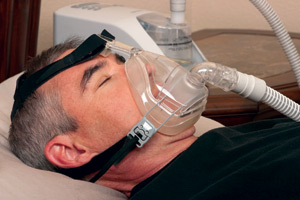Senior Reporter
Advisers Offer Sleep Apnea Guidelines as FMCSA Considers Health Proposal

This story appears in the Aug. 29 print edition of Transport Topics.
Top medical advisers to the Federal Motor Carrier Safety Administration have recommended a slate of sleep apnea guidelines that would require truck drivers to participate in costly diagnostic sleep studies if they have a body mass index of 40 or higher, experienced excessive fatigue or sleepiness while driving or have been in a sleep-related accident.
The FMCSA Medical Review Board issued its updated recommendations Aug. 22-23 to help the agency formulate a proposed rule that would offer clear guidelines for medical examiners to diagnose and treat moderate to severe obstructive sleep apnea.
Larry Minor, FMCSA’s associate administrator for policy, said last week that if the agency does issue a proposal, it would not come until sometime next year after a new presidential administration is in place.
The board’s other recommendation is that drivers at risk for apnea may be issued conditional 90-day medical certifications pending sleep study and treatment, if diagnosed with apnea.
In addition, the board said that a driver with a body mass index of from 33 to 40 should be required to take sleep studies if he or she has three of 11 factors: hypertension (treated or untreated); Type 2 diabetes (treated or untreated); a male neck size greater than 17 inches or female neck size greater than 15.5 inches; a history of stroke, coronary artery disease or arrhythmias; loud snoring; micrognathia or retrognathia (small or recessed jaw); witnessed apnea symptoms; hypothyroidism (underactive thyroid; untreated); age 42 and above; is male or post-menopausal female; or a Mallampati Scale score of class 3 or 4 (small airway).
Any driver diagnosed with sleep apnea after testing could not be given a medical certification of longer than one year, the board said.
Board member Brian Morris, corporate medical director for Quadrant Health Strategies Inc., voted to require four of the risk factors, but his objection was overruled in a 3-1 board vote.
Morris said that with only three risk factors, a large number of drivers could be sent for screening but not be found to have sleep apnea.
“Some of the three conditions, like male gender and age, are sort of automatic, in the sense that that’s the population we see,” Morris told Transport Topics. “They are usually over 42, and 95% would be male, so those are a given. I don’t want to cast such a wide net and pull in so many people because that places a burden on the system in terms of screening.”
But Gina Pervall, the board’s chairman and a certified medical review officer and associate physician for the Washington Metropolitan Area Transit Authority, said she believes the board’s recommendations will help ease driver concerns that there is no uniform standard for medical examiners to use when they make a determination whether a driver is a risk for apnea.
“I hope this will clarify questions that drivers have, as well as that the examiners have,” Pervall told TT. “Because I think part of the issue is that the examiner does not have clear instructions or guidelines to follow when referring to drivers.”
Pervall added, “I think what’s happening is that drivers are seeing a lot of variation from examiner to examiner. That’s probably causing some of the animosity.”
In a briefing to the board last week, Rebecca Brewster, president of the American Transportation Research Institute, said that the group’s survey of 800 drivers showed that the average cost of a sleep study was $1,220, due to both out-of-pocket expenses and lost time at work.
Brewster also said that there was significant concern expressed by drivers that their medical examiners could have a financial interest in making driver referrals to sleep labs that administer the sleep studies.
In its recommendations, the board said the preferred method of treatment for moderate to severe apnea is positive airway pressure, which has been proved as the most effective treatment.
Although the board said it would allow drivers to treat apnea with oral devices, it noted that the medical literature reveals the alternate method of treatment has not yet been proved effective for most moderate to severe cases of apnea.
The board made its recommendations, updated from a 2012 list of recommendations, after discussing a “matrix” of the 77 written comments from physicians and trucking and railroad industry stakeholders regarding the cost, diagnosis, screening and treatment of moderate to severe sleep apnea.
The comments were offered in response to a joint FMCSA-Federal Railroad Administration advance notice of proposed rulemaking on March 8. Neither agency is certain whether an apnea rule will be ultimately adopted.



